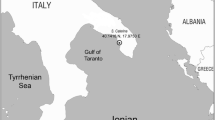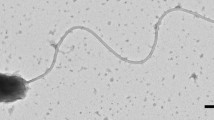Abstract
A previously unknown association between a luminous bacterium, Vibrio harveyi, and a benthic hydrozoan, Aglaophenia octodonta, is described. Aglaophenia hydrocladia showed a clear fluorescence in the folds along the hydrocaulus and at the base of the hydrotheca, suggesting the presence of luminous bacteria. This hypothesis was confirmed by isolation of luminous bacteria from Aglaophenia homogenates. Phenotypic characterization of bacterial isolates was performed by several morphological, biochemical, and cultural tests, completed with 16S rDNA sequence analysis. All the isolates were referred to a single species: V. harveyi. The association between V. harveyi and A. octodonta has epidemiological as well as ecological significance. Therefore, A. octodonta may function as habitat “islands” providing a unique set of environmental conditions for luminous bacteria colonization, quite different from those already recorded from the plankton for other Vibrio species.


Similar content being viewed by others
References
Alsina, M, Blanch, AR (1994) A set of keys for biochemical identification of environmental Vibrio species. J Appl Bacteriol 76: 352 79–85
Austin, B (1988) Marine Microbiology. Cambridge University Press, Cambridge
Baumann, P, Baumann, L (1984) Genus II. Photobacterium Beijerinck 1889R In: Kreig( NR, Holt( JG (Eds.) Bergey’s Manual of Systematic Bacteriology, vol. 1. Williams & Wilkins, Baltimore
Baumann, PS, Schubert, RHW (1984) The family II Vibrionaceae VeronR In: Krieg NR (Ed.) Bergey’s Manual of Systematic Bacteriology, vol. 1. Williams & Williams, Baltimore, pp 515–538
Baumann, P, Baumann, L, Bang, SS, Woolkalis, MJ (1980) Revalutation of the taxonomy of Vibrio, Beneckea, and Photo-bacterium—abolition of the genus Beneckea. Curr Microbiol 4: 127–133
Ben Haim, Y, Thompson, FL, Thompson, CC, Cnockaert, MC, Hoste, B, Swings, J, Rosenberg, E (2003) Vibrio coralliilyticus sp. nov., a temperature-dependent pathogen of the coral Pocillopora damicornis. Int J Syst Evol Microbiol 53: 309–315
Bouillon, J, Medel, MD, Page`s, F, Gili, J-M, Boero, F, Gravili, C (2004) Fauna of the Mediterranean Hydrozoa. Sci Mar 68(Suppl 2): 5–438
Campbell, AK (1974) Extraction, partial-purification and properties of Obelin, calcium activated luminescent protein from hydroid Obelia geniculata. Biochem J 143(2): 411–418
Cavallo, RA, Stabili, L (2002) Presence of vibrios in seawater and Mytilus galloprovincialis (Lam.) from the Mar Piccolo of Taranto (Ionian Sea). Water Res 36: 3719–3726
Cavallo, RA, Stabili, L (2004) Vibrios biodiversity in the Northern Ionian Sea (Italian coasts). Sci Mar 68(1): 23–29
Colwell, RR (1981) Microbial ecology and biofoulingR In: Colwell, RR, Pariser, ER, Siskey, AJ (Eds.) Biothecnology in the Marine Sciences. Wiley Intersciences, New York, pp 221–231
Colwell, RR (1996) Global climate and infectious disease: the cholera paradigm. Science 274: 2025–2031
Colwell, RR, Kaper, J, Seidel, R, Voll, MJ, MacNicol, LA, Gargas, S, Lockman, H, Maneval, D, Remmers, E, Joseph, SW, Bradford, H, Roberts, N, Huq, I, Huq, A (1980) Isolation of O1 and non-O1 Vibrio cholerae from estuaries and brackish waters environments. In: Proceedings of the Fifteenth U.S.–Japan Cooperative Medical Science Program Joint Conference on Cholera. NIH publication no. 80-2003. U.S. Department of Health, Education and Welfare, Bethesda, pp 44–56
Davenport, D, Nicol, JAG (1955) Luminescence in Hydromedusae. Proc R Soc London Ser B 144(916): 399–411
Farmer, JJ, Hickman-Brenner, FW (1992) The genera Vibrio and PhotobacteriumR In: Balows( A (Ed.) The Prokaryotes—A Handbook on the Biology of Bacteria: Ecophysiology, Isolation, Identification, Applications. Springer, New York, pp 2952–3011
Gomez-Gil, B, Soto-Rodriguez, S, Garcia-Gasca, A, Roque, A, Vazquez-Juarez, R, Thompson, FL, Swings, J (2004) Molecular identification of Vibrio harveyi-related isolates associated with diseased aquatic organisms. Microbiology 150: 1769–1777
Gooday, GW, Prasser, JI, Hillman, K, Cross, MG (1991) Mineralization of chitin in an estuarine sediment: The importance of the chitosan pathway. Biochem Syst Ecol 19: 395–400
Haddock, SHD, Case, JF (1999) Bioluminescence spectra of shallow and deep-sea gelatinous zooplankton: Ctenophores, medusae and siphonophores. Mar Biol (Berlin) 133(3): 571–582
Haddock, SHD, Rivers, TJ, Robison, BH (2001) Can coelenterates make coelenterazine? Dietary requirement for luciferin in cnidarian bioluminescence. Proc Nat Acad Sci USA 98(20): 11148–11151
Hansen, B, Bech, G (1996) Bacteria associated with a marine planktonic copepod in culture. I. Bacterial genera in seawater, body surface, intestines and fecal pellets and succession during fecal pellet degradation. J Plankton Res 18: 257–273
Harvey, EN (1935) Studies on bioluminescence. XIII. Luminescence in the coelenterates. Biol Bull Mar Biol Lab Woods Hole 41(5): 280–287
Herring, P (2002) Marine microlights: The luminous marine bacteria. Microbiol Today 29: 174–176
Holt, JG, Krieg, NR, Sneath, PHA, Staley, JT, Williams, ST (1994) Bergey’s Manual of Determinative Bacteriology, 9th ed. Williams & Wilkins, Baltimore, pp 943
Hood, MA, Meyers, SP (1977) Microbiological and chitinoclastic activities associated with Penaeus setiferus. J Oceanogr Soc Jpn 33: 235–241
Huq, A, Small, EB, West, PA, Huq, MI, Rahman, R, Colwell, RR (1983) Ecological relationships between Vibrio cholerae and planktonic crustacean copepods. Appl Environ Microbiol 45(1): 275–283
Kaneko, T, Colwell, RR (1975) Adsorption of Vibrio parahaemolyticus onto chitin and copepods. Appl Microbiol 29: 269–274
Lightner, DV (1993) Diseases of cultured penaeid shrimp. In: Mcvey, JP (Ed.) CRC Handbook of Mariculture, Crustacean Aquaculture. CRC Press, Boca Raton, pp 393–486
Lavilla-Pitogo, CR, Baticados, MCL, Cruz-Lacierda, ER, Pena, LD (1990) Occurrence of luminous bacterial disease of Penaeus monodon larvae in the Philippines. Aquaculture 91: 1–13
Lavilla-Pitogo, CR, Leano, EM, Paner, MG (1998) Mortalities of pond-cultured juvenile shrimp, Penaeus monodon, associated with dominance of luminescent vibrios in the rearing environment. Aquaculture 164: 337–349
Montanari, MP, Pruzzo, C, Pane, L, Colwell, RR (1999) Vibrios associated with plankton in a coastal zone of the Adriatic Sea (Italy). FEMS Microbiol Ecol 29: 241–247
Morin, JG, Hastings, JW (1971) Biochemistry of the bioluminescence of colonial hydroids and other coelenterates. J Cell Physiol 77(3): 305–312
Nealson, HK, Haygood, GM, Tebo, MB, Roman, M, Miller, E, McCosker, EJ (1984) Contribution by symbiotically luminous fishes to the occurrence and bioluminescence of luminous bacteria in seawater. Microb Ecol 10: 69–77
Nicol, JAC (1962) Animal luminescence. Adv Comp Physiol Biochem 1: 217–273
Oliver, JD, Roberts, DM, White, VK, Dry, MA, Simpson, LM (1986) Bioluminescence in a strain of the human pathogenic bacterium Vibrio vulnificus. Appl Environ Microbiol 52: 1209–1211
Olsen, GJ, Lane, DJ, Giovannoni, SJ, Pace, NR, Stahl, DA (1986) Microbial ecology and evolution: A ribosomal RNA approach. Annu Rev Microbiol 40: 337–365
Pujalte, MJ, Ortigosa, M, Macian, MC, Garay, E (1999) Aerobic and facultative anaerobic heterotrophic bacteria associated to Mediterranean oysters and seawater. Int Microbiol 2(4): 259–266
Ruby, EG, Morin, JG (1979) Luminous enteric bacteria of marine fishes: A study of their distribution densities and dispersion. Appl Environ Microbiol 38: 406–411
Sainz, JC, Maeda-Martinez, AN, Ascencio, F (1998) Experimental vibriosis induction with Vibrio alginolyticus of larvae of the Catarina scallop (Argopcten ventricosus = circularis) (Sowerby II, 1842). Microb Ecol 35: 188–192
Sambrook, J, Russell, DW (2001) Molecular Cloning. A Laboratory Manual, 3rd edn. Cold Spring Harbor Laboratory Press, Cold Spring Harbor
Svoboda, A (1979) Beitrag zur Okologie, Biometrie und Systematik der Mediterranen Aglaophenia Arten (Hydroidea). Zool Verh 167: 1–114
Svoboda, A, Cornelius, PFS (1991) The European and Mediterranean species of Aglaophenia (Cnidaria: Hydrozoa). Zool Verh 274:1–72
Tamplin, ML, Gauzens, AL, Huq, A, Sack, DA, Colwell, RR (1990) Attachment of Vibrio cholerae serogroup O1 to zooplankton and phytoplankton of Bangladesh waters. Appl Environ Microbiol 56: 1977–1980
Taylor, MW, Schupp, PJ, de Nys, R, Kjelleberg, S, Steinberg, PD (2005) Biogeography of bacteria associated with the marine sponge Cymbastela concentrica. Environ Microbiol 7(3): 419–433
Tendencia, EA (2004) The first report of Vibrio harveyi infection in the sea horse Hippocampus kuda Bleekers 1852 in the Philippines. Aquacult Res 35: 1292–1294
Vysotskii, ES, Bondar’, VS, Gitelson, I, Petrunyaka, VV, Gamalei, IA, Kaulin, AB (1990) Extraction, some properties and application of obelin, calcium activated photoprotein In: Jezowska-Trzebiatowska( B, Kochel( B, Slawinski( J, Sterk, W(Eds.) Biological Luminescence. World Scientific, Singapore, New Jersey, pp 386–395
Vysotskii, ES, Bondar’, VS, Gitelson, II (1991) Isolation and properties of different molecular forms of calcium-activated photoprotein obelin. Dokl Akad Nauk SSSR 321(1): 214–217
Vysotskii, ES, Trofimov, KP, Bondar’, VS, Gitelson, JI (1993) Luminescence of Ca2+ activated photoprotein obelin initiated by NaOCl and MnCl2. J Biolumin Chemilumin 8(6): 301–305
Vysotskii, ES, Trofimov, CP, Bondar’, VS, Frank, LA, Markova, SV, Illarionov, BA (1995) Mn2+-activated luminescence of the photoprotein obelin. Arch Biochem Biophys 316(1): 92–99
West, PA, Colwell, RR (1984) Identification and classification of vibrionaceae: An overview. In: Colwell( RR (Ed.) Vibrios in the Environment. Wiley, New York, pp 205–363
Wilson, T, Hastings, JW (1998) Bioluminescence. Annu Rev Cell Dev Biol 14: 197–230
Yu, C, Lee, AM, Bassler, BL, Roseman, S (1991) Chitin utilization by marine bacteria. A physiological function for bacterial adhesion to immobilized carbohydrates. J Biol Chem 25: 24260–24267
Aknowledgments
Financial support was provided by MURST (COFIN and FIRB projects) and the European Community (MARBEF and IASON networks, Marie Curie Project). Cecilia Bucci and Doris De Vito helped both in the field and in the laboratory. Maurizio Salvatore Tredici and Paolo D'Ambrosio provided technical support.
Author information
Authors and Affiliations
Corresponding author
Rights and permissions
About this article
Cite this article
Stabili, L., Gravili, C., Piraino, S. et al. Vibrio harveyi Associated with Aglaophenia octodonta (Hydrozoa, Cnidaria). Microb Ecol 52, 603–608 (2006). https://doi.org/10.1007/s00248-006-9010-7
Received:
Accepted:
Published:
Issue Date:
DOI: https://doi.org/10.1007/s00248-006-9010-7




